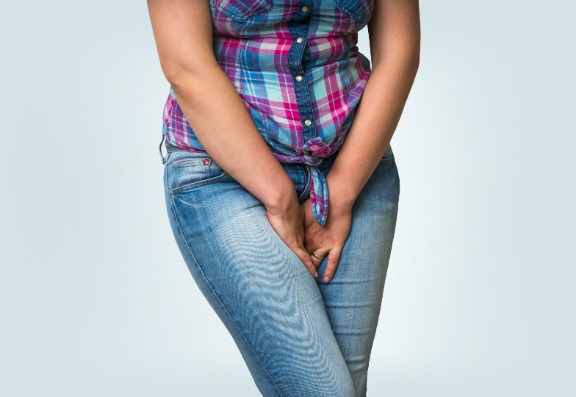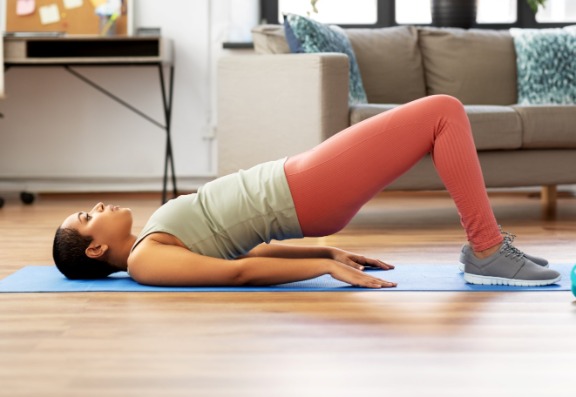Urinary incontinence is when urine leaks involuntarily from the bladder 1, 2. The severity ranges from occasionally leaking to having the urge to urinate that’s so sudden and a strong leak before reaching the toilet in time.
Urinary incontinence has a negative impact on the woman’s quality of life which could severely restrict her daily activities. Many women are unable to play sports, run, jump, sneeze or cough without the embarrassment of being incontinent and are obliged to use panty liners all the time.
Urinary incontinence is a problem in up to 40% of women, that happens commonly after childbirth and menopause but may affect women of all ages during life situations.
What are the types of urinary incontinence?
(A) Stress Urinary Incontinence (SUI): Urine leaks on straining (i.e Valsalva’s Maneuver that is the sudden rise of intraabdominal pressure) or exertion of pressure on the bladder, like in coughing, sneezing, laughing, or exercising typically leads to urine leakage involuntarily.
it is usually caused by weakness in the support of the bladder neck or urethral sphincter (weak pelvic floor muscles with prolapse/sagging of the pelvic organs. The pelvic floor muscles are controlling urine outflow and become weak after childbirth (mechanical or due to direct birth injuries) or at menopause (with atrophy of the supporting tissues as a result of ageing process and declining levels of Oestrogen/Feminine hormone).
(B) Urge incontinence (UI): urine leakage after a sudden urge/desire to pass urine but you leak on your way to the toilet. This is could be caused by a lower urinary tract infection or bladder stone or due to dysfunction in the bladder control mechanism so the bladder wall contracts overpowering your voluntary control and overcoming the urethral closing pressure (formed by the urine tube/bladder neck angle /sphincter muscle resting tone) causing some urine to leak through the urine tube opening (the urethra) against the will and without being able to stop it (called Overactive Bladder OAB, Detrusor Instability). OAB causes might be nerve damage from injury or pelvic surgery, bladder stones, diabetes, kidney disease, side effects of some drugs, and neurologic disorders like Parkinson's disease, stroke, or multiple sclerosis. But often, the cause of OAB is a mystery!
(C) Total incontinence: (Interstitial Cystitis), when the bladder fails to store urine because the walls are not able to expand to accommodate the normal capacity of urine storage volume (~250 ml), which causes you to pass urine constantly or have frequent leaking. This is usually due to chronic inflammatory conditions affecting the bladder wall called Interstitial Cystitis which has a controversial aetiology.
(D) Urinary incontinence that happens due to chronic irritation of the base of the bladder as caused by Atrophic changes in the bladder wall at menopause (Senile Trigonitis) or due to constant mechanical pressure on the bladder base by an enlarged fibroid uterus limiting the storage capacity or by the presence of a pocket of residual urine. (In Pregnancy, the growing uterus constantly exerts pressure on the bladder, therefore there is a tendency to frequent urination or even urine leakage during pregnancy).
(E) Overflow incontinence is the involuntary release of urine due to a weak bladder muscle or blockage, thence the bladder becomes overly full, and leaks even though the person feels no urge to urinate. overflow incontinence is more common in men than women. The most common cause in men is an enlarged prostate, which impedes the flow of urine out of the bladder. Other possible causes of overflow incontinence include:
Blockages of the urethra (the tube that carries urine from the bladder to outside the body) from tumours, urinary stones, scar tissue, swelling from infection, or kinks caused by dropping of the bladder within the abdomen
Weak bladder muscles, which are unable to squeeze the bladder empty
Injury of nerves that affect the bladder
Nerve damage from diseases such as diabetes, alcoholism, Parkinson's disease, multiple sclerosis, back problems/back surgery, or spina bifida
Medications, including some anticonvulsants and antidepressants, affect nerve signals to the bladder.
Urinary incontinence: Here is a variety of factors of causes: 1, 2
Surgery: some women who have a hysterectomy or prolapse repair suffer from incontinence afterwards.
Pregnancy and childbirth: A vaginal delivery can cause damage to pelvic nerves and muscles, resulting in an overactive bladder. Instrumentally assisted delivery (by forceps or Suction Ventouse) leads to a stretch of the pelvic supportive ligaments and connective tissue with loss of elasticity, weakness and sagging of the bladder neck with the uterus or the vaginal walls. (Cystocele, Cysto-ureterocele).
Obesity: Excess body weight increases abdominal pressure which in turn increases bladder pressure and mobility of the urethra.

Menopause: Menopause can cause the pelvic floor muscle to weaken and the bladder loses its elasticity.
Chronic cough: By causing the pelvic floor muscle to relax momentarily and leakage of urine.
Chronic constipation: An overfull bowel (due to constipation) can press on the bladder, reducing the amount of urine it can hold.
Gynaecological factors: Like uterovaginal prolapse (sagging) or pressure by large tumours like fibromyomas or an ovarian cyst or in distortion caused by endometriosis.
Urinary Incontinence: Who should do your assessment?
It is prudent to identify the type/cause of urinary incontinence accurately to devise a suitable treatment plan. The assessment ideally should be carried out by a highly qualified and experienced OBandGY Specialist/Consultant who is knowledgeable on the standards of ICS and able to have a holistic and specialized "Uro-Gynae Evaluation", select cases' suitability to a matching procedure(s) and personalise the treatment plan to maximise the success rate.
Urinary Incontinence: What does assessment entail?
Taking full medical history: Demographic, Obstetric, Gynaecological including info on lifestyle or daily habits, etc.
Urine analysis: It is an office procedure or at the lab where a mid-stream urine sample is checked for signs of infection, traces of blood or other abnormalities.
Bladder diary: A record of how much you drink and urinate for several days and whether you have the urge to urinate.
Post-void residual measurement: Using an ultrasound machine to measure the amount (volume) of urine leftover remaining in your bladder following urination.
Cystometry, Uroflowmetry, Urodynamic studies: That is the bladder function tests using very fine catheters threaded into the urine tube to measure the pressure changes inside the bladder wall and interpreted against the changes in pressure inside the tammy (intraabdominal pressure) gauged by another fine catheter that is passed through the back passage opening. The graphs of both pressures are recorded during urine provocation tests and during passing urine.

Urinary Incontinence: What are the treatment options?
(A) Conservative lifestyle recommendations.
1- Do pelvic floor exercises (Kegel’s exercises) to strengthen pelvic floor muscles
2- Stop smoking and treat chronic coughing that puts strain on pelvic floor muscles
3- Reducing the amount of caffeine and spicy food
4- Bladder training
- Avoid lifting which puts strain on pelvic floor muscles
- lose excess weight since being overweight causes the pressure of fatty tissue on your bladder
- Treat constipation promptly to preserve pelvic floor muscles
(B) Medicinal treatment
Anticholinergics are the most common OAB medications. You take them by mouth at least once a day.
Topical Oestrogen; vaginal rings, tablets, or creams are also prescribed to treat women's OAB symptoms.
(C) Surgical interventions: As indicated, advised and performed by an experienced Gynaecologist after full clinical assessment and counselling about the success rate, risks, potential complications, and recurrence rate.
Prolapse treatment procedures include anterior colporrhaphy, posterior colporrhaphy or colpoperineorrhaphy, autologous sling grafts (artificial mesh procedures are prohibited), laparoscopic colposuspension, (vaginoplasty) with or without hysterectomy, others like Clam’s procedure, etc.
(D) Minimally invasive/office procedures: Cystoscopic Neurotoxin injection (Botulinum A) 3-7 into the bladder muscle wall [intravesical] partially paralyzes it to ease overactivity but leaves enough control. Also, can use an injection of sclerotic fillers into the bladder neck.
(E) Non-surgical options: An initial full Gynaecological assessment by an expert Gynaecologist is crucial for case selection. These non-surgical procedures are strongly advised and recommended to be performed by the efficient Gynaecologist who knows best in the microanatomy and physiology of this feminine area. Hence, the experienced Gynaecologist knows best; capable to select the ideal procedure to achieve the highest possible success rate according to individual variations and circumstances.
1 - Non-Surgical Aesthetic/Regenerative Gynaecology Procedures: What are they?
i-Laser treatment 8-10
Laser therapy has been proven to be successful in treating disorders affected by collagen damage by promoting the synthesis of collagen in the connective supporting endopelvic fascia/tissues around the bladder outlet with an excellent safety record.
Laser therapy stimulates blood flow to the affected areas, bringing healing and rejuvenation to the pelvic floor muscle, vaginal walls and urethra. The increased blood flow and better tissue tone lead to better urinary function.
A laser beam is aimed at the area to stimulate the body’s healing repose and production of collagen and elastin which are essential components of healthy cells.
ii-Radiofrequency treatment 11, 12,
Temperature-controlled radiofrequency generating machines are used for the treatment of mild to moderate urinary incontinence (as selected by an experienced Gynaecologist) that help tighten the underlying connective and supportive tissues of the vagina, urethra and tissues beneath the bladder.
iii-Platelet Rich Plasma injection 13-15
The autologous platelet-rich plasma (PRP) whether the one known as an “O” Shot or Urethral PRP injection is safe and effective in increasing urethral resistance and improving SUI. PRP could be an alternative treatment modality for male and female patients with moderate SUI due to non-neurogenic causes.
iv-Other Autologous Cell grafts: Like Stem Cell Therapy and ESWT 16-20
ADSC: adipose-derived stem cell or BMSCs: bone marrow-derived mesenchymal stem cell or human umbilical cord blood stem cells (HUCBs) and total nucleated cells (TNCs) are directly and locally injected into the urethra/ bladder neck in SUI. Studies showed that the median improvement rate of intrinsic sphincter deficiency after ADSCs, MDSCs, TNCs, and HUCBs injections were 88%, 77%, 89%, and 36% (improvement rate: 1-2 pads) at a mean (range) follow-up of 6 (1-72) months. The cell sources, methods of cell processing, cell number, and implantation techniques differed considerably between studies. Most of the periurethral injections were at the 3, 5, 7, and 9 o'clock positions and for submucosa were at the 4, 6, and 8 o'clock positions. No significant postoperative complications were reported.
Recently ESWT has been found very useful in the treatment of intractable cases of Interstitial Cystitis in both genders.
All references can be found here.
If you want to read more, the experts at Consulting Room really know what they're talking about and have put together scarring, PRP injections and non-surgical vulvovaginal rejuvenation FAQs just for you.
If you have more questions, you can use the scarring, PRP injections and non-surgical vulvovaginal rejuvenation questions feature to talk to our panel of trained medical experts.
If you're keen to get started with any of these treatments immediately, then you're in luck. Those clever folks also have a list of trusted, accredited scarring, PRP injections and non-surgical vulvovaginal rejuvenation clinics in your area.
Many thanks to the author of this blog, Dr Nadia Yousri who is the owner of Dr Nadia Yousri OBandGY.
Doctor Nadia Yousri is Triple Qualified OBandGY Surgeon (FRCOG, MRCOG, PhD in OBandGY, Master's Degree in OBandGY, DFSRH) and is a highly qualified and experienced Obstetrician, Gynaecologist, Fertility, Sexual Wellness, Aesthetic Gynaecology and Regenerative Medicine Specialist Consultant.
Call Dr Nadia Yousri now on 0777 576 1050 or visit www.drnyaesthetics.com.

Hey, wait!
Before you go.....
Let's stay in touch, pop your details here and we'll send our editor's hand-picked updates on your fave subjects.